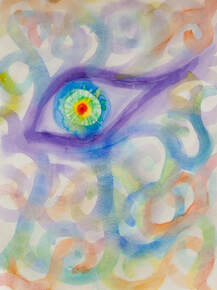Approaches to Psychotherapy
 The sound of a bowl bell is used to introduce mindful hearing.
The sound of a bowl bell is used to introduce mindful hearing.
Mindfulness
Do you suffer from stress, chronic pain, or stubborn, unwanted patterns of behavior or emotion? Would you benefit from an increased ability to relax, stronger concentration, greater awareness, and deepening insights into your personal style of being in the world? If you answered “yes” to any of the above, then the practice of mindfulness is right for you. (For a more extensive list of the benefits of mindfulness, click here.)
Jon Kabat-Zinn, PhD, describes mindfulness as paying attention on purpose and without judgment to what is happening in the present moment. This way of paying attention can be practiced with any of our senses as well as in relation to our inner experience of thoughts, emotions, and imagery. When learning mindfulness we usually begin simply with mindfulness of breathing as an inner form of experience and mindful hearing as a way to attend to external sensory input. Gradually the practice is expanded until in includes all aspects of our experience. Once a good foundation of mindfulness is developed, it can be used as the central element in a deepening inquiry into dysfunctional patterns of emotion and belief and their relationship to our experience of our body and our behavior. This exploration leads to reduced stress, greater self-understanding, improved relationships, and a growing ease of living.
A faculty member of the University of Massachusetts Medical School, Kabat-Zinn, developed a secular application of mindfulness for stress reduction and pain management that is now used in many hospitals and medical centers throughout the United States, including the Kaiser Permanente system in California. His approach to mindfulness, called Mindfulness-Based Stress Reduction (MBSR), is now also taught in prisons, juvenile halls, corporations, and is used in several evidence-based psychotherapeutic modalities. Just in the past few years, mindfulness is also being taught with great benefit in some schools. (See my section on Mindfulness for Children.)
Jon’s protocol has also been adapted to address depression and anxiety for use with groups and individuals. Research has shown that mindfulness can be effective with a wide range of other clinical issues as well.
Do you suffer from stress, chronic pain, or stubborn, unwanted patterns of behavior or emotion? Would you benefit from an increased ability to relax, stronger concentration, greater awareness, and deepening insights into your personal style of being in the world? If you answered “yes” to any of the above, then the practice of mindfulness is right for you. (For a more extensive list of the benefits of mindfulness, click here.)
Jon Kabat-Zinn, PhD, describes mindfulness as paying attention on purpose and without judgment to what is happening in the present moment. This way of paying attention can be practiced with any of our senses as well as in relation to our inner experience of thoughts, emotions, and imagery. When learning mindfulness we usually begin simply with mindfulness of breathing as an inner form of experience and mindful hearing as a way to attend to external sensory input. Gradually the practice is expanded until in includes all aspects of our experience. Once a good foundation of mindfulness is developed, it can be used as the central element in a deepening inquiry into dysfunctional patterns of emotion and belief and their relationship to our experience of our body and our behavior. This exploration leads to reduced stress, greater self-understanding, improved relationships, and a growing ease of living.
A faculty member of the University of Massachusetts Medical School, Kabat-Zinn, developed a secular application of mindfulness for stress reduction and pain management that is now used in many hospitals and medical centers throughout the United States, including the Kaiser Permanente system in California. His approach to mindfulness, called Mindfulness-Based Stress Reduction (MBSR), is now also taught in prisons, juvenile halls, corporations, and is used in several evidence-based psychotherapeutic modalities. Just in the past few years, mindfulness is also being taught with great benefit in some schools. (See my section on Mindfulness for Children.)
Jon’s protocol has also been adapted to address depression and anxiety for use with groups and individuals. Research has shown that mindfulness can be effective with a wide range of other clinical issues as well.
Cognitive Therapy
Cognitive Therapy identifies and works to change dysfunctional thoughts and emotional responses, and the unskillful behaviors they evoke. Together the therapist and client explore the accuracy of thoughts, seeking to correct underlying beliefs that may be unrealistic or unhelpful. Once the thinking process becomes more accurate, behavior begins to shift as do the client’s emotional reactions to challenging life situations.
Mindfulness is critical to this process in that present-moment attention to thinking, emotions, and behavior helps the client identify problematic areas to explore. Mindfulness then guides the exploration process and helps the client track the changes that emerge as well. Yoga Nidra, or iRest, is an additional mindfulness-based tool that can be used to explore particularly challenging beliefs and emotions.
Mindfulness is critical to this process in that present-moment attention to thinking, emotions, and behavior helps the client identify problematic areas to explore. Mindfulness then guides the exploration process and helps the client track the changes that emerge as well. Yoga Nidra, or iRest, is an additional mindfulness-based tool that can be used to explore particularly challenging beliefs and emotions.
Cognitive Therapy identifies and works to change dysfunctional thoughts and emotional responses, and the unskillful behaviors they evoke. Together the therapist and client explore the accuracy of thoughts, seeking to correct underlying beliefs that may be unrealistic or unhelpful. Once the thinking process becomes more accurate, behavior begins to shift as do the client’s emotional reactions to challenging life situations.
Mindfulness is critical to this process in that present-moment attention to thinking, emotions, and behavior helps the client identify problematic areas to explore. Mindfulness then guides the exploration process and helps the client track the changes that emerge as well. Yoga Nidra, or iRest, is an additional mindfulness-based tool that can be used to explore particularly challenging beliefs and emotions.
Mindfulness is critical to this process in that present-moment attention to thinking, emotions, and behavior helps the client identify problematic areas to explore. Mindfulness then guides the exploration process and helps the client track the changes that emerge as well. Yoga Nidra, or iRest, is an additional mindfulness-based tool that can be used to explore particularly challenging beliefs and emotions.
 Artistic imagery emerges from the unconscious.
Artistic imagery emerges from the unconscious.
Imaginal Psychology
My use of Imaginal Psychology emphasizes the inherent capacity to heal that lives within us all. The notion that psychology is first and foremost imaginal acknowledges the central role of imagery in this innate, though generally unconscious healing capacity. Our inner healer uses imagery as a primary mode for communicating its healing message to the conscious mind.
The imagery that emerges from within us through dreams, artistic creativity, reverie, ritual, or meditation/prayer, serves as our guide. It reveals hidden meaningful patterns in our life. In so doing it points us towards our deepest natural and uniquely personal expression of the underlying wholeness of which we are a part. As our exploration of this imagery deepens, it brings us into an intimate experiential relationship with this primordial unity. Ultimately our healing emerges as our own spontaneous expression of the singular activity of the Cosmos. In this process our depression, our anxiety, our compulsions, our dysfunctional relationships are transformed.
My use of Imaginal Psychology draws on the work of Carl Jung, James Hillman, Aftab Omer, and Tsultrim Allione among others.
My use of Imaginal Psychology emphasizes the inherent capacity to heal that lives within us all. The notion that psychology is first and foremost imaginal acknowledges the central role of imagery in this innate, though generally unconscious healing capacity. Our inner healer uses imagery as a primary mode for communicating its healing message to the conscious mind.
The imagery that emerges from within us through dreams, artistic creativity, reverie, ritual, or meditation/prayer, serves as our guide. It reveals hidden meaningful patterns in our life. In so doing it points us towards our deepest natural and uniquely personal expression of the underlying wholeness of which we are a part. As our exploration of this imagery deepens, it brings us into an intimate experiential relationship with this primordial unity. Ultimately our healing emerges as our own spontaneous expression of the singular activity of the Cosmos. In this process our depression, our anxiety, our compulsions, our dysfunctional relationships are transformed.
My use of Imaginal Psychology draws on the work of Carl Jung, James Hillman, Aftab Omer, and Tsultrim Allione among others.

Energy Psychology
My use of Imaginal Psychology emphasizes the inherent capacity to heal that lives within us all. The notion that psychology is first and foremost imaginal acknowledges the central role of imagery in this innate, though generally unconscious healing capacity. Our inner healer uses imagery as a primary mode for communicating its healing message to the conscious mind.
The imagery that emerges from within us through dreams, artistic creativity, reverie, ritual, or meditation/prayer, serves as our guide. It reveals hidden meaningful patterns in our life. In so doing it points us towards our deepest natural and uniquely personal expression of the underlying wholeness of which we are a part. As our exploration of this imagery deepens, it brings us into an intimate experiential relationship with this primordial unity. Ultimately our healing emerges as our own spontaneous expression of the singular activity of the Cosmos. In this process our depression, our anxiety, our compulsions, our dysfunctional relationships are transformed.
My use of Imaginal Psychology draws on the work of Carl Jung, James Hillman, Aftab Omer, and Tsultrim Allione among others.
My use of Imaginal Psychology emphasizes the inherent capacity to heal that lives within us all. The notion that psychology is first and foremost imaginal acknowledges the central role of imagery in this innate, though generally unconscious healing capacity. Our inner healer uses imagery as a primary mode for communicating its healing message to the conscious mind.
The imagery that emerges from within us through dreams, artistic creativity, reverie, ritual, or meditation/prayer, serves as our guide. It reveals hidden meaningful patterns in our life. In so doing it points us towards our deepest natural and uniquely personal expression of the underlying wholeness of which we are a part. As our exploration of this imagery deepens, it brings us into an intimate experiential relationship with this primordial unity. Ultimately our healing emerges as our own spontaneous expression of the singular activity of the Cosmos. In this process our depression, our anxiety, our compulsions, our dysfunctional relationships are transformed.
My use of Imaginal Psychology draws on the work of Carl Jung, James Hillman, Aftab Omer, and Tsultrim Allione among others.

Benefits of Mindfulness
A recent survey of the research literature on mindfulness lists the following as benefits:
A recent survey of the research literature on mindfulness lists the following as benefits:
- Increased self-awareness, self-trust, and self-acceptance.
- Enhanced appreciation of life.
- Serenity in the face of difficulties.
- More accepting attitude toward life and its challenges.
- More fluid adaptation to change and development of more effective coping strategies.
- Significant decreases in anxiety and depression.
- Considerable reduction in the chances that depression will return.
- Improved concentration and creativity.
- Lasting decreases in a variety of stress-related physical symptoms, including chronic pain.
- Improved immune system functioning.